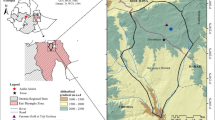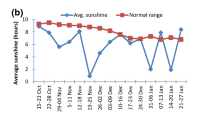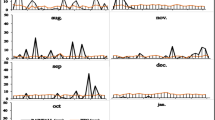Abstract
In semi-arid areas on the Western Loess Plateau, China, crop growth has been greatly limited by water supply. The comparative wet season in the region runs from July through September, and about 60 % of the yearly precipitation total falls within this period. Rainfall is very sparse from November of the preceding year through June of the following year. Water harvesting agriculture has been shown to be one of the most efficient ways to increase water use efficiency (WUE) and crop productivity for wheat, corn, broccoli etc. however, research on WUE in potato (Solanum tuberosum L.), one of the dominant crops in the area, is sparse. Field experiments on supplemental irrigation (amount and timing) using catchment rainfall were carried out in both 2008 and 2009 in Dingxi, a typical potato growing area, for the purpose of determining effective utilization of the limited supplemental irrigation water for potatoes. Soil water storage, evapotranspiration (ET), WUE, irrigation water use efficiency (IWUE), tuber yield and size and starch and protein contents were determined in this research. The results showed that both ET and tuber yield increased with supplemental irrigation, consequently WUE was improved. IWUE appeared to be better with 45 mm of irrigation applied at the vegetative growth stage and tuber yield was increased by 7–18 % compared to the treatment without irrigation (T1), and WUE and IWUE were significantly higher than other treatments in both years. Compared to the control, WUE with 45 mm of irrigation at the vegetative growth stage increased by 1.28 % and 2.17 % in 2008 and 2009, respectively. In addition, 45 mm of irrigation at the vegetative growth stage also increased the percentage of large tubers, and the sum of large and medium tubers. Tubers under such practice were of acceptable size and had the highest protein content. Therefore, we conclude, 45 mm of supplemental irrigation at the vegetative growth stage is the best way to use the limited available supplemental irrigation water from catchment rainfall for rain-fed potatoes grown in semi-arid areas on the Western Loess Plateau of China. Applying more water, or at a later growth stage of potato, was less effective.
Resumen
En las zonas semi-áridas en el valle del oeste de Loess, en China, el crecimiento del cultivo se ha limitado grandemente por el suministro de agua. La temporada húmeda comparativa en la región corre de julio hasta septiembre, y cerca del 60 % de la precipitación anual total cae dentro de este período. La lluvia es muy escasa de noviembre del año previo hasta junio del siguiente año. Se ha visto que la cosecha de agua en la agricultura es una de las maneras más eficaces de aumentar el uso del agua eficientemente (WUE) y de la productividad de los cultivos para trigo, maíz, brócoli, etc., no obstante, es escasa la investigación en WUE en papa (Solanum tuberosum L.), uno de los cultivos dominantes en el área. Se llevaron a cabo experimentos de campo en riego suplementario (cantidad y tiempo) utilizando captación de lluvia en 2008 y 2009 en Dingxi, un área típica de cultivo de papa, con el propósito de determinar la utilización efectiva del agua de riego suplementario limitado en papa. En esta investigación se determinaron el almacenamiento del agua del suelo, evapotranspiración (ET), WUE, eficiencia del uso del agua de riego (IWUE), tamaño y rendimiento de tubérculo, y los contenidos de almidón y proteína. Los resultados mostraron que tanto ET como el rendimiento de tubérculo aumentaron con riego suplementario, consecuentemente, se mejoró el WUE. Parecía ser mejor el WUE con 45 mm de riego aplicado en el estado de crecimiento vegetativo, y el rendimiento de tubérculo se incrementó en 7–18 % comparado con el tratamiento sin riego (T1), y el WUE y el IWUE fueron significativamente mas altos que en otros tratamientos en ambos años. En comparación con el testigo, WUE con 45 mm de riego en el estado vegetativo aumentó en 1.28 % y 2.17 % en 2008 y 2009, respectivamente. Además, 45 mm de riego en la fase vegetativa también incrementó el porcentaje de tubérculos grandes y la suma de grandes y medianos. Los tubérculos bajo dicha práctica fueron de tamaño aceptable y tuvieron el contenido proteico más alto. De aquí que concluimos que 45 mm de riego suplementario en la fase vegetativa es la mejor manera de usar el agua de riego suplementaria limitada disponible, de la captación de agua de lluvia para papas de secano o temporal, cultivadas en zonas semi-áridas en el valle del oeste de Loess de China. La aplicación de más agua, o en una fase de crecimiento posterior, fue menos efectiva.

Similar content being viewed by others
References
Bélanger, G., J.R. Walsh, J.E. Richards, P.H. Milburn, and N. Ziadi. 2000. Yield response of two potato culivars to supplemental irrigation and N fertilization in New Brunswick. American Journal of Potato Research 77(1): 11–21.
Chen, G.R., S.M. Gao, X.Y. Zhang, W. Zhang, and Y.H. Wang. 2008. The effect of potassium application and water supplement in different stages on potato yield and WUE in semiarid area. Agricultural Research in the Arid Areas 26(5): 41–46 (in Chinese).
Chinese Soil Taxonomy Cooperative Research Group. 1995. Chinese soil taxonomy (revised proposal). Institute of Soil Science, Academic Sinica, 204–206. Beijing: Chinese Agricultural Science and Technology Press. in Chinese.
Chu, P.F., D. Wang, Y.L. Zhang, X.Y. Wang, X.Z. Wang, and Z.W. Yu. 2009. Effects of irrigation stage and amount on water consumption characteristics, grain yield and content of protein components of wheat. Scientia Agricultural Sinica 42(4): 1306–1315 (in Chinese).
FAO. 1990. Fertilizer Yearbook, vol. 39. Rome: FAO.
Faraji, A., N. Latifi, A. Soltani, and A.H.S. Rad. 2009. Seed yield and water use efficiency of canola (Brassica napus L.) as affected by high temperature stress and supplemental irrigation. Agricultural Water Management 96(1): 132–140.
Galantini, J.A., M.R. Landriscini, J.O. Iglesias, A.M. Miglierina, and R.A. Rosell. 2000. The effects of crop rotation and fertilization on wheat productivity in the Pampean semiarid region of Argentina: 2. Nutrient balance, yield and grain quality. Soil and Tillage Research 53(2): 137–144.
Geigenberger, P., R. Reimholz, M. Geiger, L. Merlo, V. Canale, and M. Stitt. 1997. Regulation of sucrose and starch metabolism in potato tubers in response to short-term water deficit. Biomedical and Life Sciences 201(502–518).
Hang, A.N., and D.E. Miller. 1986. Yield and Physiological Responses of Potatoes to Deficit, High Frequency Sprinkler Irrigation. Agronomy Journal 78: 436–440.
He, X.F., H.H. Cao, and F.M. Li. 2007. Econometric analysis of the determinants of adoption of rainwater harvesting and supplementary irrigation technology (RHSIT) in the semiarid Loess Plateau of China. Agricultural water management 89(3): 243–250.
Herriman, T., and U. Schmida. 2000. Rainwater utilization in Germany: Efficiency, dimensioning, hydraulic and environmental aspects. Urban Water 9: 307–316.
Hou, X.Y., F.X. Wang, J.J. Han, S.Z. Kang, and S.Y. Feng. 2010. Duration of plastic mulch for potato growth under drip irrigation in an arid region of Northwest China. Agricultural and Forest Meteorology 150(1): 115–121.
Kahinda, J.M., A.E. Taigbenu, and J.R. Boroto. 2007. Domestic rainwater harvesting to improve water supply in rural South Africa. Physics and Chemistry of the Earth, Parts A/B/C 32(15–18): 1050–1057.
Lahlou, O., and J.F. Ledent. 2005. Root mass and depth, stolons and roots formed on stolons in four cultivars of potato under water stress. European Journal of Agronomy 22(2): 159–173.
Li, X.Y., and J.D. Gong. 2002. Compacted microcatchments with local earth materials for rainwater harvesting in the semiarid region of China. Journal of Hydrology 257: 134–144.
Lu, W.D. 2004. Statistical analysis of SPSS for Windows, 50–55. Beijing: Electronic industry publishing company. in Chinese.
Nishiyama, S., Y.H. Kang, and B.Z. Yuan. 2003. Effects of different irrigation regimes on the growth and yield of drip-irrigated potato. Agricultural Water Management 63: 153–167.
Ojala, J.C., J.C. Stark, and G.E. Kleinkopf. 1990. Influence of irrigation and nitrogen management on potato yield and quality. American Potato Journal 67: 29–43.
Oweis, T., and A. Hachum. 2009. Optimizing supplemental irrigation: Tradeoffs between profitability and sustainability. Agricultural Water Management 96(3): 511–516.
Porter, G.A., G.A. Opena, W.B. Bradbury, I.C. McBurnie, and J.A. Sisson. 1999. Soil management and supplemental irrigation effects on potato: I. Soil properties, tuber yield, and quality. Agronomy Journal 91: 416–125.
Qin, S.H., and L.L. Li. 2005. Accumulation and distribution of dry matter and grain filling of spring wheat postanthesis under supplementary irrigation catchments rainfall. Journal of Soil and Water Conservation 19(4): 173–177. in Chinese.
Rockstrom, J., J. Barron, and P. Fox. 2002. Rain water management for increased productivity among small-holder farmer in drought prone environments. Physics and Chemistry of the Earth 27: 949–959.
Ryan, A.M., C.L. Spash, and T.G. Measham. 2009. Socio-economic and psychological predictors of domestic greywater and rainwater collection: Evidence from Australia. Journal of Hydrology 379(1–2): 164–171.
Sazakli, E., A. Alexopoulos, and M. Leotsinidis. 2007. Rainwater harvesting, quality assessment and utilization in Kefalonia Island, Greece. Water Research 41(9): 2039–2047.
Shan, L., and M. Xu. 1991. Water-saving agriculture and its physio-ecological bases. Chinese Journal of Applied Ecology 2(1): 70–76. in Chinese.
Shock, C.C., A.B. Pereira, and E.P. Eldredge. 2007. Irrigation best management practices for potato. American Journal of Potato Research 84: 29–37.
Silver, D., E. Afeworki, and G. Criner. 2011. Cost of supplemental irrigation for potato production in Maine. Maine Agricultural & Forest Experiment Station Technical Bulletin 205, Orono. P. 2.
Walworth, J.L., and D.E. Carling. 2002. Tuber initiation and development in irrigated and non-irrigated potatoes. American Journal of Potato Research 79(6): 387–395.
Wang, Y. 2005. Study on protein determination experiment. Research and Exploration in Laboratory 24(4): 58–59.
Wang, Y.J., Z.S. Zhang, Z.K. Xie, X.H. Wei, and F.Q. Li. 2003. The effect of supplementary rain water irrigation on broccoli in the northwest Loess Plateau of China. Journal of Lanzhou University (Natural Science) 39(3): 64–68 (in Chinese).
William, H.B., S.B. Johnson. 2010. The Potato Association of America Handbook. Commercial Potato Production in North America. Second Revision of American Potato Journal Supplement Volume 57 and USDA Handbook 267 by the Extension Section of The Potato Association of America. p 54.
Xiao, G.J., Q. Zhang, Y.C. Xiong, M.Z. Lin, and J. Wang. 2007. Integrating rainwater harvesting with supplemental irrigation into rain-fed spring wheat farming. Soil and Tillage Research 93(2): 429–437.
Xie, Z.K., Y.J. Wang, S.H. Chen, Z.S. Zhang, and X.H. Wei. 2003. Effect of supplemental irrigation with harvested rainwater on watermelon production in gravel-and-plastic mulched fields in the Loess Plateau of Northwest China. Acta Ecologica Sinica 23(10): 2033–2039 (in Chinese).
Yao, X.L., X.Z. Din, Y.Y. CHen, and L.K. Wu. 2005. Correlativity between apparent starch contents and amylose contents in potato. Acta Bot.Boreal.-Occident.Sin 25(5): 953–957.
Yuan, F.M., and W.L. Bland. 2005. Comparison of light and temperature based index models for potato (Solanum tuberosum L.) growth and development. American Journal of Potato Research 82: 345–352.
Zhang, J.X., D.W. Zheng, F. Li, and Y. Duan. 2008. Water using and transforming efficiency of rainwater harvesting:concept and ways of enhancing. Agricultural Research in the Arid Areas 26(3): 198–204 (in Chinese).
Zhu, X., Y. Li, X. Peng, and S. Zhang. 1983. Soils of the loess region in China. Geoderma 29(3): 237–255.
Acknowledgements
This research was financially supported by National Natural Science Foundation of China (31260311), Gansu Provincial Key Laboratory of Aridland Crop Science (GSCS-2010-09), the Ministry of Agriculture (CARS-10-P18), the Ministry of Education (212185), China Postdoctoral Science Foundation (2012M512042) and Gansu Provincial Department of Science and Technology (1104NKCA084, 1102NKDM025). All the authors are grateful for all the students and staff in Dingxi Rainfed agricultural Research Institute for their assistance in field work. The authors are also grateful to Albert Oates from Australia and Michele Konschuh from Canada for their kind work in suggesting improvements to this paper.
Author information
Authors and Affiliations
Corresponding author
Rights and permissions
About this article
Cite this article
Qin, S., Li, L., Wang, D. et al. Effects of Limited Supplemental Irrigation with Catchment Rainfall on Rain-fed Potato in Semi-arid Areas on the Western Loess Plateau, China. Am. J. Potato Res. 90, 33–42 (2013). https://doi.org/10.1007/s12230-012-9267-y
Published:
Issue Date:
DOI: https://doi.org/10.1007/s12230-012-9267-y




